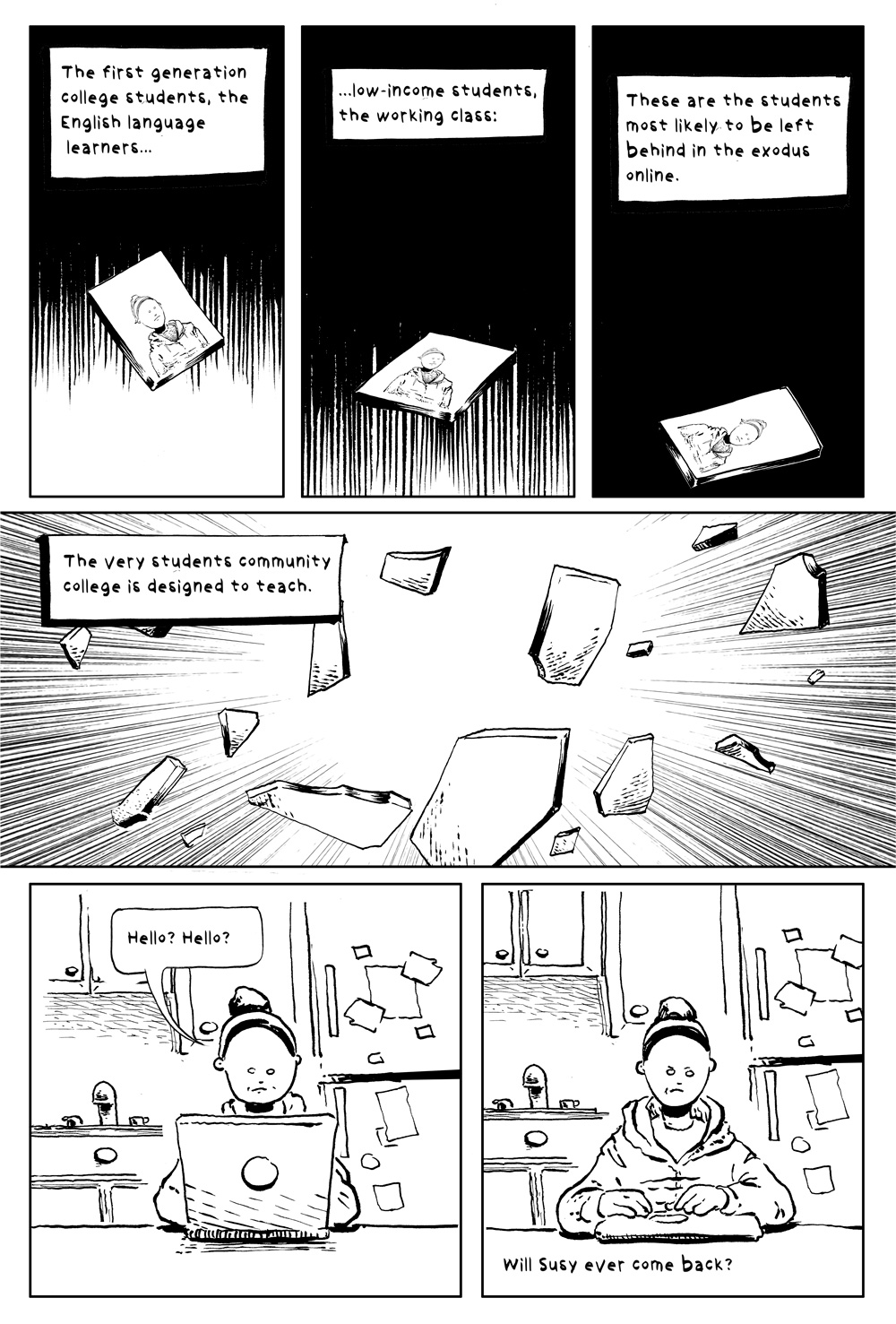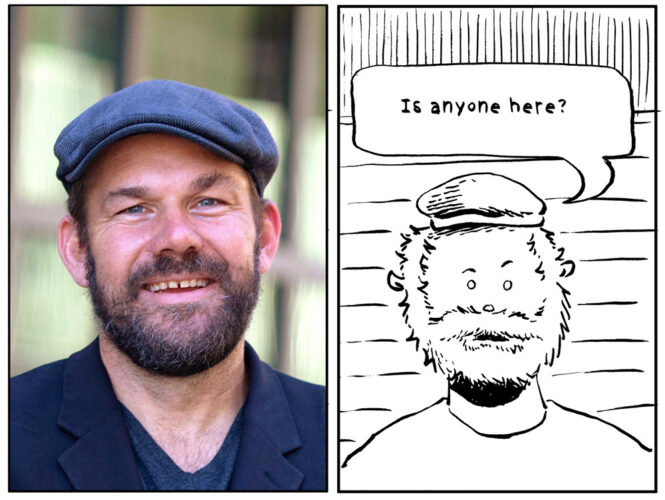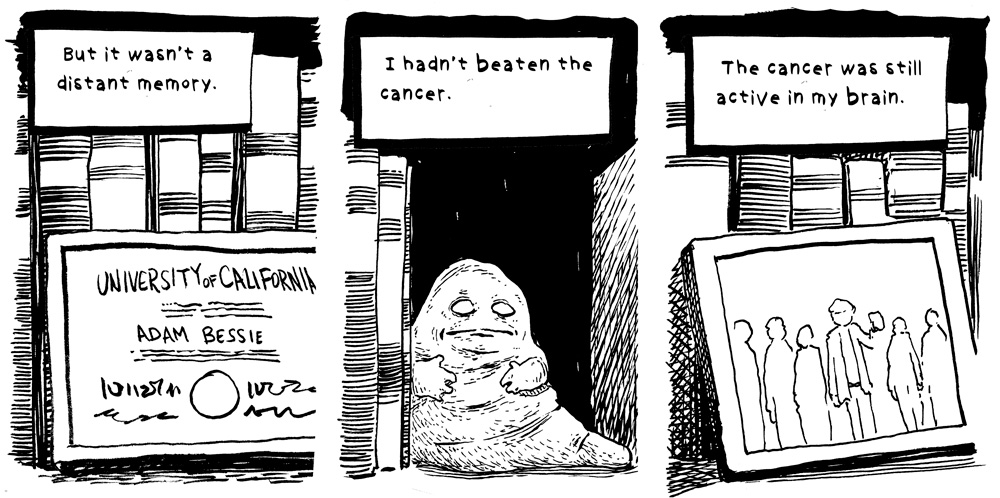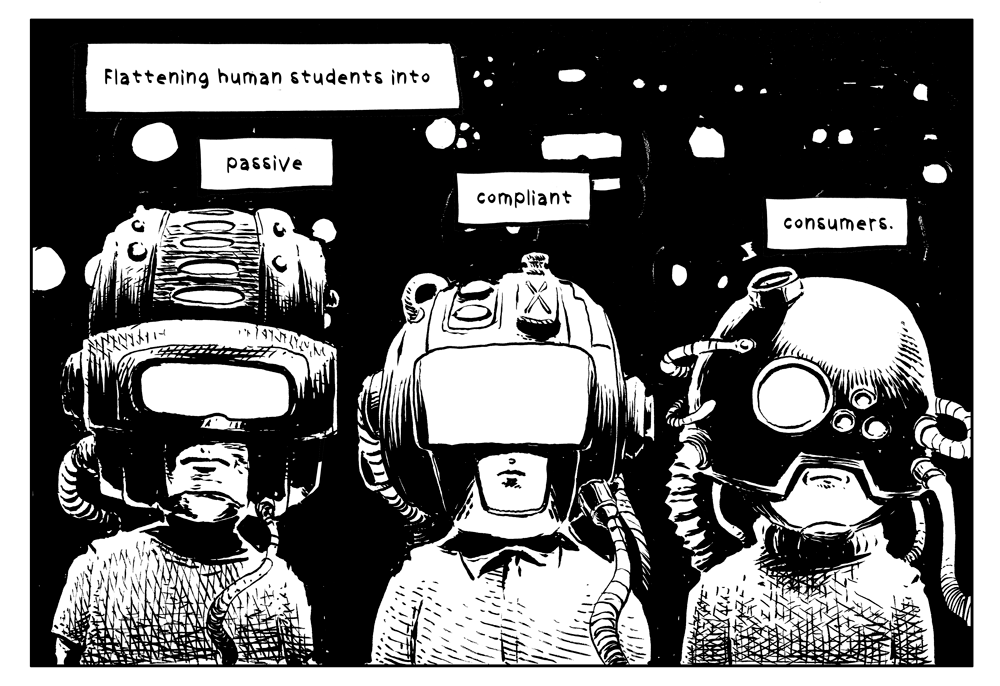In New Graphic Novel, Pandemic Scatters a Vulnerable School Community
Community college professor's debut work traces COVID’s “diaspora” of marginalized students
By Greg Toppo | March 17, 2023When the pandemic shut down Adam Bessie’s classroom in March 2020, the longtime California community college instructor was teaching a unit titled, appropriately enough, “The End of the World as We Know it: The Literature of the Apocalypse.”
Better yet, his students were discussing “The Machine Stops,” a 1909 E.M. Forster story in which future humans live in isolation, even from family members, forever in fear of toxic air and human contact. The characters see each other only through screens.
Forster’s story frames the narrative of Going Remote: A Teacher’s Journey, the debut graphic memoir by Bessie, along with the artist Peter Glanting, which offers a surreal, often grim take on the pandemic and its effects on both Bessie and his students. The book also bemoans the “diaspora” that the pandemic brought forth, concluding that while it didn’t create “inequality, standardization and corporatization” in public education, it made them more “painfully visible” than ever.

So far the book is garnering lavish praise: Publishers Weekly gave it a coveted “starred” review, calling it “poignant” and excerpting one of the chapters. It also named it one of Spring 2023’s Top 10 graphic novels and adult comics.
Bessie entered the Spring 2020 semester in the middle of a personal crisis, returning to campus as he recovered from chemotherapy after surgery to remove a brain tumor. He had long enjoyed the infectious energy and “electrical current” that flows through a good classroom, invoking educator Bob Moses’ observation that students are “the power in the room.”
So he naturally mourned the loss of face-to-face instruction and dreaded the flattening that took place on Zoom. Once distinctive, quirky individuals, his students quickly became “identical in size, dimension, proportion, equal tiles in a perfect grid.” They often showed up with cameras and microphones turned off, “black boxes on mute.”
That sudden absence gave Bessie the opportunity to step back and see the transformation taking place not just in his classroom but in his life, as he continued cancer treatments. He began to see himself as an experimental subject whose day job was guiding his own students through another kind of experiment, as his college broadened its pre-pandemic reliance on technologies like Zoom, Canvas and Google. While these tools tethered the community together during the crisis, he writes, they also came with their own strict demands: access to a computer, stable wifi and a quiet study space, all parameters “set by the software requirements,” not educators. These demands soon overwhelmed many students, some of whom never returned.
In an interview, the longtime English instructor said giving in to these demands could threaten community colleges’ open access mission, squeezing out the neediest students — the very students they’re designed to uplift. In a way, he said, the book is an exploration of this question: “To what degree are we ceding public control of the Commons to corporations?”

The narrative in Going Remote, Bessie said, “was immediately a comic. I knew from the beginning that I wanted to express this story in a graphic form.” As soon as the pandemic began, he found himself “writing and drawing to myself about this, because I said, ‘There is going to be something new after this.’ … I had this feeling like, ‘This is going to be a major shift.’”
He’d always been drawn to comics, largely for their ability to translate abstract, complex concepts into visual form — early on, Glanting, the artist, illustrates Bessie’s lingering brain cancer as a pint-sized, white-eyed blob, leaning against a stack of books on a shelf in Bessie’s office.

Bessie also drew inspiration from the graphic adaptation of University of Illinois scholar William Ayers’ memoir To Teach.
Like Ayers, Bessie writes from a distinctly leftist perspective, making the case that community colleges from the beginning were both profoundly democratic and “steeped with the virus of classist and racist contempt” for their students, part stepping stool and part gate-keeper.
Community colleges play a big role in Bessie’s own family history: His father, a penniless Korean War veteran who suffered a “profound hearing loss,” enrolled in a California community college and found educators who believed in his potential, despite his disability. He eventually found his way to the University of Southern California, training to become a physical therapist and going on to a successful career.
“When I come into the classroom, I still have that feeling: Each one of these students is somebody that could have been my own father, is somebody that society didn’t think would be educated,” he said.
Yet he also warns that there’s a dark side to community colleges’ legacy. Founded more than a century ago, the system began with an intentional design, he said, that, just as often as it uplifted marginalized students like Bessie’s father, excluded others from the mainstream of elite higher education.
So in the winter of 2020, when his students — starting with his “most marginalized” and ending with his best, most outgoing students — began disappearing altogether from Zoom, Bessie was, in a way, not surprised. Whether beset by technical problems, work and family obligations, or something else altogether, he concluded that they were really the victims of a kind of longstanding neglect that systematically deprives them of opportunities.

Even now, three years after the first lockdowns, with students slowly returning to campus (Bessie never reveals the name of his Bay Area institution, Diablo Valley College), he said he and his colleagues must take on more responsibilities, becoming “frontline emotional workers” to students in crisis: Since late 2020, he has served on his campus CARE (Campus Assessment, Response, and Evaluation) team, which works with students experiencing homelessness, mental health issues, family crises, and even spousal abuse. Since the pandemic, he said, CARE reports “have gone through the roof.”
He sees this as a key function of institutions like Diablo Valley.
“When I’m looking at the future of community college, to me, I want us to put as much energy in these systems of care as we do in these systems of technology. … All of us were trained in how to use online technology. But none of us were trained in what to do when a student says, ‘I attempted suicide.’”
Now back in the classroom roughly half-time — Bessie is teaching two fully in-person classes and two hybrid classes — he feels “more optimistic than I did in finishing the book.” Classes, he said, have “amazing energy,” with engaging conversations about readings that resemble those he and his students enjoyed pre-pandemic.
And he’s doing his best to remain open-minded about technology. The series of remote semesters, he said, actually forced him to consider not just how students can shine in an online classroom, but also the limitations of face-to-face teaching. When he’s teaching online, for instance, students who didn’t hear something the first time — he’s a very fast talker, he’ll admit — can go back and rewatch the lesson.
Excerpt from Going Remote: A Teacher’s Journey, published by Seven Stories Press
But he still has concerns. Enrollment, for one thing, has dropped “precipitously” since the pandemic, forcing the college to reduce offerings. Ironically, even though Zoom proved to be difficult for many students, a fair share are now clamoring for remote, fully asynchronous classes. He worries that, given the hybrid schedule, many new students will never get “that campus experience … of being pulled into community.” Between lower enrollment and online coursework, he estimated, the college seems about one-fourth as populated as in 2019.
In the end, though, it’s “more vibrant than when I finished the book,” he said. A few days ago, for the first time in months, he smelled the aroma of someone vaping tobacco outside his office building. And then he heard someone else playing music a bit too loud. “And I was just like, ‘Yes, we’re back!’”
Get stories like these delivered straight to your inbox. Sign up for The 74 Newsletter

